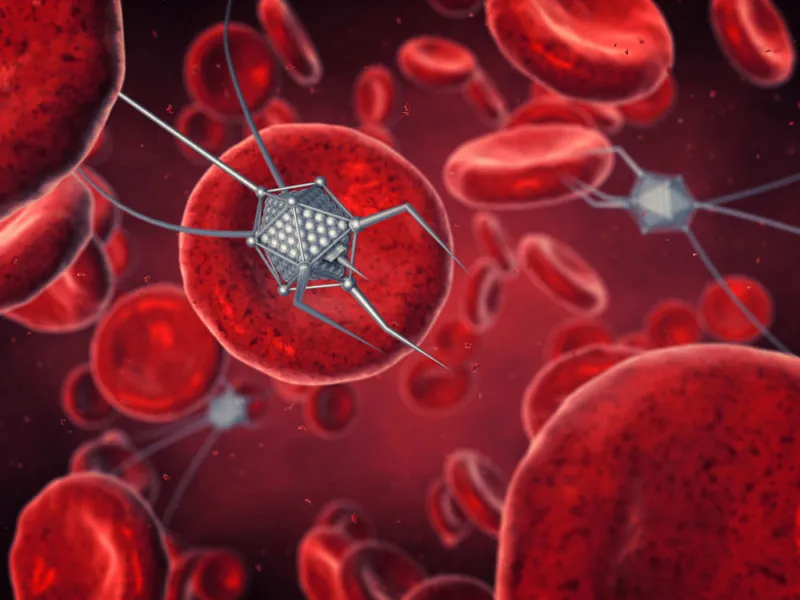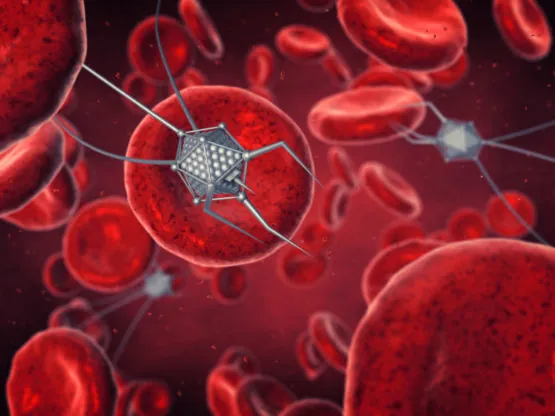Using Nanoscale Robots to Fight Aging and Disease
At least in the developed world, cancer, heart diseases, and neurodegenerative diseases are among the greatest causes of mortality. One emerging and very promising way to prevent or cure these diseases is through bio-nanotechnology.
Nanotechnology is the design, synthesis and application of materials or devices that are on the nanometer scale (one billionth of a meter). Due to the small scale of these devices, they can have many beneficial applications, both in industry and medicine. The use of nanodevices in medicine is called nanomedicine. Here, we will look at some applications of nanomedicine in curing or preventing the diseases that are most likely to kill us.
Fighting cancer
A paper published in January 2018 describes a DNA origami autonomous robot that is able to specifically target cancer tumor cells [1]. The nanorobot has a cylindrical shape. It has a DNA aptamer (a molecule that binds to another, specific target molecule) on the outside. This aptamer binds specifically to nucleolin, a protein that is significantly expressed on tumor-associated endothelial cells (cells that line the interior surface of blood vessels), thus giving the nanorobot specificity to tumor cells. The inside of the cylinder contains thrombin, a molecule that causes blood to coagulate. The DNA aptamer on the outside of the cylinder also acts as a trigger to open the cylinder upon binding to nucleolin. Therefore, when the nanorobot binds nucleolin in the blood vessels that are close to tumor cells (and which supply the tumor with blood, thus keeping it alive), it opens up and exposes thrombin, causing blood to coagulate. This, in turn, cuts the blood supply to the tumor. Without this blood supply, the cancerous cells die. This has so far been demonstrated to work in mice.
Fighting neurodegenerative diseases
Neurodegenerative diseases are diseases that affect the brain. The brain is special among our organs; it stores all our memories and personalities, so it cannot simply be replaced once it wears out or becomes damaged. Being such an important organ, it also has a special defense mechanism in the form of the blood-brain barrier. The blood-brain barrier has a role in protecting the brain from foreign substances by impeding the passage of molecules. However, it is also an impediment to delivering therapeutic drugs to the brain; drugs that are intended for the brain must be delivered in very high doses. Nanodevices can be engineered to have several components, each having their own role, and they make drug delivery to the brain more efficient [2-3]. For example, nanodevices can contain a component that recognizes a specific site, thus “going” to that specific place in the brain. It can contain another component that holds the drug, and another component serves as a trigger that releases the drug upon binding to the desired location. This allows better crossing of the blood-brain barrier through sustained local release.
These devices must cross the blood-brain barrier because the brain, like other organs, accumulates amyloid plaques that interfere with its normal functioning [4]. These are a result of normal metabolism and accumulate over the years. In fact, they are present in all of us right now, but most of us do not have sufficient amounts to have any effect. However, if we live long enough and nothing else kills us, these plaques will. We cannot simply stop the metabolic processes that lead to the formation of these plaques, but we can potentially get rid of them directly by engineering nanodevices that specifically target them and that have a sort of enzyme that breaks these plaques apart, rendering them harmless. Indeed, it has been shown that some nanoparticles can interact with amyloids, thus hindering the assembly of amyloid monomers, resolubilizing them, and preventing their toxic effects.
Preventing heart disease
Coronary heart disease (CHD) is the major cause of death in the developed world. It comes as a result of plaque formation over the years in the coronary artery (the artery that supplies oxygen-rich blood to the heart muscle). This plaque is made of fat, cholesterol, calcium, and other substances in the blood. It gradually accumulates over the years at a rate that can be faster or slower, depending on lifestyle and diet, but as with amyloid plaques, it continuously builds up during your lifetime, and if nothing else kills you, CHD will.
A group of scientists has managed to make nanoparticles that specifically target these plaques. They engineered lipid-based molecules with a protein at one end. When placed into an aqueous environment, these molecules aggregate to form a sphere, called a micelle, which has the proteins on its surface. These surface proteins detect and specifically bind to plaques as demonstrated in mouse studies [5]. On top of this, the surface proteins can be changed and adapted to different purposes. This is just the first step in developing multifunctional nanorobots that bind and then specifically break down these plaques, thus reducing or preventing the risk of a heart attack caused by these plaques.
Current technology
A 2011 paper described the first nanodevices tested in humans [6]. These were magnetic resonance imaging (MRI)-guided nanocapsules made for precise drug delivery. The nanocapsules were composed of several components, including a nanocarrier (where the drug was attached, and which gave solubility and biocompatibility to the nanocapsule), a sensing element that detected the status of the environment, and many components responsible for guiding the nanocapsules to the desired locations. This can be seen as a precursor to controllable precision nanorobots that we will use in the future for medical purposes.
Future nanorobots
Future nanorobots could be bacteria-sized and have many components that act independently, such as recognition and attachment components, enzymatic components, and even components that perform surgery at the nanoscale [7]. Robots that have nanoscale laser systems, nanoneedles, or nanotweezers may possibly be able to manipulate nanostructures, perform nanosurgery, revolutionize medicine, and have an enormous positive impact on our lives.
Conclusion
Nanorobots have an immense potential for life extension and rejuvenation technologies can be helpful for the entire field of medical science, and can potentially become some of our best allies in the fight against aging and diseases.
Literature
[1] Li, S. et al. (2018). A DNA nanorobot functions as a cancer therapeutic in response to a molecular trigger in vivo. Nature Biotechnology, 36, 258-64.
[2] Re, F., Gregori, M., and Masserini, M. (2012). Nanotechnology for neurodegenerative disorders. Nanomedicine: Nanotechnology, Biology and Medicine, 8(S1), pp. S51-58.
[3] Silva Adaya, D. et al. (2017). Nanobiomaterials’ applications in neurodegenerative diseases. Journal of Biomaterials Applications, 31(7), pp. 953-84.
[4] de Grey, A., and Rae, M. (2007). Ending Aging: The Rejuvenation Breakthroughs that Could Reverse Human Aging in Our Lifetime. St. Martin’s Press.
[5] Peters, D. et al. (2009). Targeting atherosclerosis by using modular, multifunctional micelles. Proceedings of the National Academy of Sciences of the United States of America, 106(24), pp. 9815-9.
[6] Vartholomeos, P. et al. (2011). MRI-guided nanorobotic systems for therapeutic and diagnostic applications. Annual Review of Biomedical Engineering, 15(13), pp. 157-84.
[7] Leary, S. P., Liu, C. Y., and Apuzzo, M. L. (2006). Toward the emergence of nanoneurosurgery: part III–nanomedicine: targeted nanotherapy, nanosurgery, and progress toward the realization of nanoneurosurgery. Neurosurgery, 58(6), pp. 1009-26.
About the author




